| Auras T6C
Heatsink From All Angles |
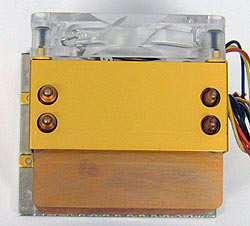 |
The Fan:
Two 6mm diameter copper heatpipes
punctuate the
aluminum
fan shroud at either edge of
the top of the
heatsink. A
15mm thick fan sits on its' side and blows cool air over the copper fins.
The fan comes equipped with four blue LEDs for added effect, and draws approx. 0.4A. The
fan connects to the motherboard fan header and supports RPM monitoring. |
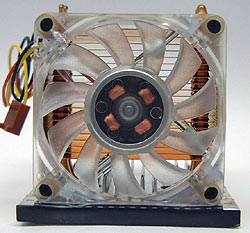 |
Heatsink Top:
The fan glows a nice bright blue when powered
up, but is somewhat noisy under power. An small fan controller with thermal sensor comes bundled
along with the T6C heatsink, so you can configure it
to respond to increases in temperature while remaining quieter
throughout. The fan controller is a little bit of a rats nest of wires,
but gets the job done of supplying power to the fan, and even RPM signals
to the mainboard. Note the black tape which conceals the 1.4mm thick copper
base plate. |
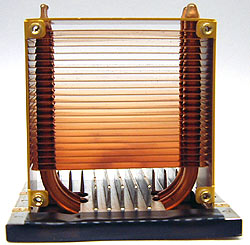 |
Fan Removed:
With the fan removed it is a little clearer
how the T6C is constructed. The two "U" shaped heatpipes are soldered to the 1.4mm
thick copper base and then pass through a series of 20 0.25mm thick
copper fins. The copper fins measure approximately 50x67mm in size and are spaced 2mm apart from one
another. The supporting base of the heatsink is made from a nickel-plated cast aluminum section,
which also appears to have been brazed, or soldered to the thin copper base plate.
|
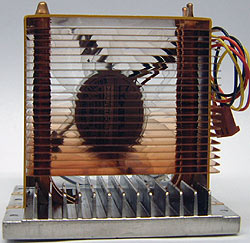 |
Side A:
The base is largely constructed from cast aluminum
which has been nickel plated to allow it to be brazed or soldered to the
copper below. A dozen or so, short and stubby aluminum fins are built into the
framework. |
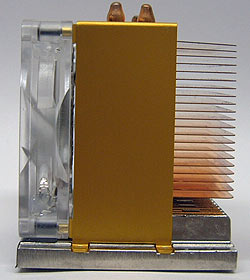 |
Side B:
A simple
combination of fan, heatpipes, copper fins, and an aluminum base are
all that make up the T6C heatsink. The aluminum fan shroud is there to help direct
the exhaust from the blue LED illuminated fan out through the copper fins of the
heatsink. |
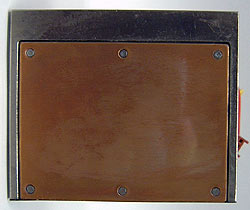 |
Heatsink Base:
The copper base is fairly thin, and held in place
with small rivets at the outer corners on the aluminum frame. The surface is
smooth, and fairly flat. A good thermal compound is recommended for
use. |


